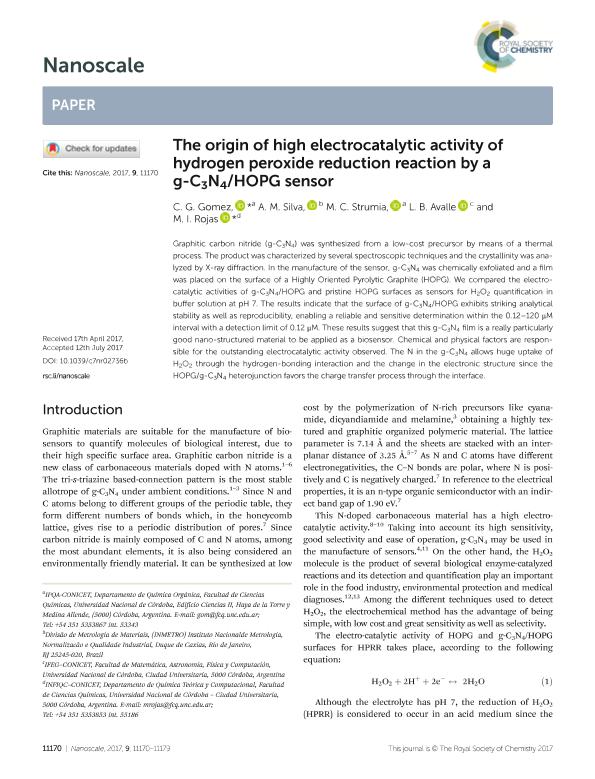Artículo
The origin of high electrocatalytic activity of hydrogen peroxide reduction reaction by a g-C3N4/HOPG sensor
Gomez, Cesar Gerardo ; Silva, Alexander Martins; Strumia, Miriam Cristina
; Silva, Alexander Martins; Strumia, Miriam Cristina ; Avalle, Lucia Bernardita
; Avalle, Lucia Bernardita ; Rojas, Mariana Isabel
; Rojas, Mariana Isabel
 ; Silva, Alexander Martins; Strumia, Miriam Cristina
; Silva, Alexander Martins; Strumia, Miriam Cristina ; Avalle, Lucia Bernardita
; Avalle, Lucia Bernardita ; Rojas, Mariana Isabel
; Rojas, Mariana Isabel
Fecha de publicación:
08/2017
Editorial:
Royal Society of Chemistry
Revista:
Nanoscale
ISSN:
2040-3372
Idioma:
Inglés
Tipo de recurso:
Artículo publicado
Clasificación temática:
Resumen
Graphitic carbon nitride (g-C3N4) was synthesized from a low-cost precursor by means of a thermal process. The product was characterized by several spectroscopic techniques and the crystallinity was analyzed by X-ray diffraction. In the manufacture of the sensor, g-C3N4 was chemically exfoliated and a film was placed on the surface of a Highly Oriented Pyrolytic Graphite (HOPG). We compared the electrocatalytic activities of g-C3N4/HOPG and pristine HOPG surfaces as sensors for H2O2 quantification in buffer solution at pH 7. The results indicate that the surface of g-C3N4/HOPG exhibits striking analytical stability as well as reproducibility, enabling a reliable and sensitive determination within the 0.12-120 μM interval with a detection limit of 0.12 μM. These results suggest that this g-C3N4 film is a really particularly good nano-structured material to be applied as a biosensor. Chemical and physical factors are responsible for the outstanding electrocatalytic activity observed. The N in the g-C3N4 allows huge uptake of H2O2 through the hydrogen-bonding interaction and the change in the electronic structure since the HOPG/g-C3N4 heterojunction favors the charge transfer process through the interface.
Palabras clave:
Hopg
,
G-C3n4
,
Electrocatalisis
Archivos asociados
Licencia
Identificadores
Colecciones
Articulos(INFIQC)
Articulos de INST.DE INVESTIGACIONES EN FISICO- QUIMICA DE CORDOBA
Articulos de INST.DE INVESTIGACIONES EN FISICO- QUIMICA DE CORDOBA
Articulos(IPQA)
Articulos deINSTITUTO DE INVESTIGACION Y DESARROLLO EN INGENIERIA DE PROCESOS Y QUIMICA APLICADA
Articulos deINSTITUTO DE INVESTIGACION Y DESARROLLO EN INGENIERIA DE PROCESOS Y QUIMICA APLICADA
Articulos(SEDE CENTRAL)
Articulos de SEDE CENTRAL
Articulos de SEDE CENTRAL
Citación
Gomez, Cesar Gerardo; Silva, Alexander Martins; Strumia, Miriam Cristina; Avalle, Lucia Bernardita; Rojas, Mariana Isabel; The origin of high electrocatalytic activity of hydrogen peroxide reduction reaction by a g-C3N4/HOPG sensor; Royal Society of Chemistry; Nanoscale; 9; 31; 8-2017; 11170-11179
Compartir
Altmétricas



